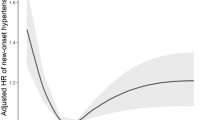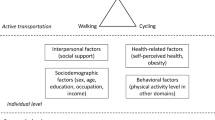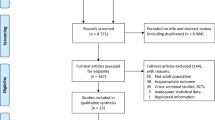Abstract
Purpose of Review
Bicycling as a mode of transportation can be an easy and inexpensive way of integrating health enhancing physical activity into everyday life. In the present paper, we summarize the evidence from studies on bicycling for transportation and recreation in relation to cardiovascular disease prevention. We also estimate the population impact of increasing bicycling as a mode of transportation.
Recent Findings
The overall evidence from prospective cohort studies supports that bicycling for transportation or recreation is related to lower risk of development of fatal or non-fatal cardiovascular disease and premature mortality. The decreased risk of cardiovascular disease and all-cause mortality from regular bicycling is estimated to outweigh risk from additional exposure to air pollution during outdoor exercise. Also, based on experimental studies on the effect of bicycling to school or work, we report an average increase (summary effect) on cardiorespiratory fitness of 3.56 ml O2/min/kg (95% CI 2.79 to 4.32) compared with control. Extrapolating the size of this average difference, approximately equivalent to 1 MET, then a right shift in the fitness distribution among adults in the general population would lead to substantial reductions in cases of fatal and non-fatal cardiovascular disease and type 2 diabetes. Furthermore, we estimate a significant impact on cardiovascular mortality under plausible public health intervention scenarios increasing the percentage of the population bicycling to work.
Summary
Bicycling remains an underutilized alternative to motorized transport in most countries, and promoting bicycling could be a viable approach in primordial and primary prevention of cardiovascular diseases.

Similar content being viewed by others
References
Papers of particular interest, published recently, have been highlighted as: • Of importance •• Of major importance
Sallis JF, Bull F, Guthold R, Heath GW, Inoue S, Kelly P, et al. Progress in physical activity over the Olympic quadrennium. Lancet. 2016;388(10051):1325–36.
Heinen E, Maat K, van Wee B. The effect of work-related factors on the bicycle commute mode choice in the Netherlands. Transportation. 2013;40(1):23–43.
International Energy Agency. CO2 emissions from fuel combustion - highlights. 2017.
Matthews CE, Jurj AL, Xo S, Li HL, Yang G, Li Q, et al. Influence of exercise, walking, cycling, and overall nonexercise physical activity on mortality in Chinese women. Am J Epidemiol. 2007;165(12):1343–50.
Andersen LB, Schnohr P, Schroll M, Hein HO. All-cause mortality associated with physical activity during leisure time, work, sports, and cycling to work. Arch Intern Med. 2000;160(11):1621–8.
• Celis-Morales CA, Lyall DM, Welsh P, Anderson J, Steell L, Guo Y, et al. Association between active commuting and incident cardiovascular disease, cancer, and mortality: prospective cohort study. BMJ. 2017;357:j1456. Celis-Morales et al. examined the relationship between commuter bicycling and risk of fatal- and non-fatal cardiovascular disease and all-cause mortality in a large cohort of men and women from the UK. The authors reported that bicycling as commuting mode was associated with a lower risk of cardiovascular disease, and all cause mortality compared with non-active commuters.
Sahlqvist S, Goodman A, Simmons RK, Khaw KT, Cavill N, Foster C, et al. The association of cycling with all-cause, cardiovascular and cancer mortality: findings from the population-based EPIC-Norfolk cohort. BMJ Open. 2013;3(11):e003797.
• Østergaard L, Jensen MK, Overvad K, Tjonneland A, Grøntved A. Associations between changes in cycling and all-cause mortality risk. Am J Prev Med. 2018;55(5):615–23. Østergaard et al. ivestigated changes in bicycling habits over five years and risk of mortality from all-causes among Danish men and women. The authors reported that initiation of or continued engagement in bicycling late in mid-life was associated with a lower risk of mortality.
• Koolhaas CM, Dhana K, Schoufour JD, Lahousse L, van Rooij FJA, Ikram MA, et al. Physical activity and cause-specific mortality: the Rotterdam Study. Int J Epidemiol. 2018;47(5):1705–13. In a cohort study among Dutch men and women, Koolhaas et al. report that all-cause mortality risk was lower with increasing levels of bicycling.
Hoevenaar-Blom MP, Wendel-Vos GC, Spijkerman AM, Kromhout D, Verschuren WM. Cycling and sports, but not walking, are associated with 10-year cardiovascular disease incidence: the MORGEN Study. Eur J Cardiovasc Prev Rehabil. 2011;18(1):41–7.
• Blond K, Jensen MK, Rasmussen MG, Overvad K, Tjonneland A, Ostergaard L, et al. Prospective study of bicycling and risk of coronary heart disease in Danish men and women. Circulation. 2016;134(18):1409–11. Blond et al. examined the association of bicycling with the risk of coronary heart diseases in a cohort study of Danish men and women. The authors reported a lower risk of coronary heart disease among participants reporting bicycling at baseline. Also, they reported that changing cycling behavior between baseline and second examination from no cycling to cycling was associated with lower heart disease risk compared with no cycling.
Armstrong ME, Green J, Reeves GK, Beral V, Cairns BJ, Million Women Study C. Frequent physical activity may not reduce vascular disease risk as much as moderate activity: large prospective study of women in the United Kingdom. Circulation. 2015;131(8):721–9.
Koolhaas CM, Dhana K, Golubic R, Schoufour JD, Hofman A, van Rooij FJ, et al. Physical activity types and coronary heart disease risk in middle-aged and elderly persons: the Rotterdam Study. Am J Epidemiol. 2016;183(8):729–38.
Millett C, Agrawal S, Sullivan R, Vaz M, Kurpad A, Bharathi AV, et al. Associations between active travel to work and overweight, hypertension, and diabetes in India: a cross-sectional study. PLoS Med. 2013;10(6):e1001459.
Laverty AA, Mindell JS, Webb EA, Millett C. Active travel to work and cardiovascular risk factors in the United Kingdom. Am J Prev Med. 2013;45(3):282–8.
Riiser A, Solbraa A, Jenum AK, Birkeland KI, Andersen LB. Cycling and walking for transport and their associations with diabetes and risk factors for cardiovascular disease. J Transp Health. 2018;11:193–201.
Ostergaard L, Grontved A, Borrestad LA, Froberg K, Gravesen M, Andersen LB. Cycling to school is associated with lower BMI and lower odds of being overweight or obese in a large population-based study of Danish adolescents. J Phys Act Health. 2012;9(5):617–25.
Andersen LB, Wedderkopp N, Kristensen P, Moller NC, Froberg K, Cooper AR. Cycling to school and cardiovascular risk factors: a longitudinal study. J Phys Act Health. 2011;8(8):1025–33.
•• Grøntved A, Koivula RW, Johansson I, Wennberg P, Ostergaard L, Hallmans G, et al. Bicycling to work and primordial prevention of cardiovascular risk: a cohort study among Swedish men and women. J Am Heart Assoc. 2016;5(11). Grøntved et al. examined 10-year risk of clinical cardiovasvular risk factors according to bicycling to work and changes in communting habits among more than 20,000 Swedish men and women residing in a bicycling friendly environment. Bicycling to work was associated with a lower risk of incident obesity, hypertension, hypertriglyceridemia, and impaired glucose tolerance compared with passive travel with evidence of dose–response relationships according to numbers of seasons spent bicycling as well as commuting distance.
Rasmussen MG, Overvad K, Tjonneland A, Jensen MK, Ostergaard L, Grontved A. Changes in cycling and incidence of overweight and obesity among Danish men and women. Med Sci Sports Exerc. 2018;50:1413–21.
• Rasmussen MG, Grontved A, Blond K, Overvad K, Tjonneland A, Jensen MK, et al. Associations between recreational and commuter cycling, changes in cycling, and type 2 diabetes risk: a cohort study of Danish men and women. PLoS Med. 2016;13(7):e1002076. Rasmussen et al. examined the relationship of bicycling and changes herein with the risk of incident type 2 diabetes in a large cohort of Danish men and women. Bicycling for commuting and recreational purpose was reported being consistently associated with lower risk of type 2 diabetes.
Moller NC, Ostergaard L, Gade JR, Nielsen JL, Andersen LB. The effect on cardiorespiratory fitness after an 8-week period of commuter cycling--a randomized controlled study in adults. Prev Med. 2011;53(3):172–7.
•• Blond MB, Rosenkilde M, Gram AS, Tindborg M, Christensen AN, Quist JS, et al. How does 6 months of active bike commuting or leisure-time exercise affect insulin sensitivity, cardiorespiratory fitness and intra-abdominal fat? A randomised controlled trial in individuals with overweight and obesity. Br J Sports Med. 2019:bjsports-2018-100036. Blond et al. compared the effect of bicycle commuting with control or structured leisure time exercise on glucose metabolism, adiposity and fitness in a randomized controlled trial among overweight or obese and inactive adults. Participants allocated to bicycling to work or school intervention significantly improved peripheral insulin sensitivity, cardiorespiratory fitness, and adiposity levels compared with control.
Quist JS, Rosenkilde M, Petersen MB, Gram AS, Sjodin A, Stallknecht B. Effects of active commuting and leisure-time exercise on fat loss in women and men with overweight and obesity: a randomized controlled trial. Int J Obes. 2018;42(3):469–78.
De Geus B, Joncheere J, Meeusen R. Commuter cycling: effect on physical performance in untrained men and women in Flanders: minimum dose to improve indexes of fitness. Scand J Med Sci Sports. 2009;19(2):179–87.
Oja P, Männttäri A, Heinonen A, Kukkonen-Harjula K, Laukkanen R, Pasanen M, et al. Physiological effects of walking and cycling to work. Scand J Med Sci Sports. 1991;1(3):151–7.
Hendriksen IJ, Zuiderveld B, Kemper HC, Bezemer PD. Effect of commuter cycling on physical performance of male and female employees. Med Sci Sports Exerc. 2000;32(2):504–10.
Cesaroni G, Forastiere F, Stafoggia M, Andersen ZJ, Badaloni C, Beelen R, et al. Long term exposure to ambient air pollution and incidence of acute coronary events: prospective cohort study and meta-analysis in 11 European cohorts from the ESCAPE Project. BMJ. 2014;348:f7412.
Brook RD, Rajagopalan S, Pope CA 3rd, Brook JR, Bhatnagar A, Diez-Roux AV, et al. Particulate matter air pollution and cardiovascular disease: an update to the scientific statement from the American Heart Association. Circulation. 2010;121(21):2331–78.
Andersen ZJ, de Nazelle A, Mendez MA, Garcia-Aymerich J, Hertel O, Tjonneland A, et al. A study of the combined effects of physical activity and air pollution on mortality in elderly urban residents: the Danish Diet, Cancer, and Health cohort. Environ Health Perspect. 2015;123(6):557–63.
Fisher JE, Loft S, Ulrik CS, Raaschou-Nielsen O, Hertel O, Tjonneland A, et al. Physical activity, air pollution, and the risk of asthma and chronic obstructive pulmonary disease. Am J Respir Crit Care Med. 2016;194(7):855–65.
Kubesch NJ, Therming Jorgensen J, Hoffmann B, Loft S, Nieuwenhuijsen MJ, Raaschou-Nielsen O, et al. Effects of leisure-time and transport-related physical activities on the risk of incident and recurrent myocardial infarction and interaction with traffic-related air pollution: a cohort study. J Am Heart Assoc. 2018;7(15).
Sinharay R, Gong J, Barratt B, Ohman-Strickland P, Ernst S, Kelly FJ, et al. Respiratory and cardiovascular responses to walking down a traffic-polluted road compared with walking in a traffic-free area in participants aged 60 years and older with chronic lung or heart disease and age-matched healthy controls: a randomised, crossover study. Lancet. 2018;391(10118):339–49.
Region Syddanmark. Hvordan Har du det? - trivsel, sundhed og sygdom blandt voksne i Region Syddanmark. 2017.
Hallal PC, Andersen LB, Bull FC, Guthold R, Haskell W, Ekelund U, et al. Global physical activity levels: surveillance progress, pitfalls, and prospects. Lancet. 2012;380(9838):247–57.
Barendregt JJ, Veerman JL. Categorical versus continuous risk factors and the calculation of potential impact fractions. J Epidemiol Community Health. 2010;64(3):209–12.
Sex of workers by means of transportation to work universe: workers 16 years and over. US Census Bureau, 2016 American Community Survey 1-Year Estimates.
Centers for Disease Control and Prevention, National Center for Health Statistics. Compressed Mortality File 1999-2016 on CDC WONDER Online Database, released June 2017. Data are from the Compressed Mortality File 1999–2016 Series 20 No. 2U, 2016, as compiled from data provided by the 57 vital statistics jurisdictions through the Vital Statistics Cooperative Program. Accessed at http://wonder.cdc.gov/cmf-icd10.html on Apr 8, 2019.
Commuting to work by gender, UK country and region. Office for National Statistics. Accessed at https://www.ons.gov.uk/employmentandlabourmarket/peopleinwork/employmentandemployeetypes/datasets/commutingtoworkbygenderukcountryandregion on Apr 8, 2019.
British Heart Foundation. Heart and circulatory diseases statistics 2018. Accessed at https://www.bhf.org.uk/what-we-do/our-research/heart-statistics/heart-statistics-publications/cardiovascular-disease-statistics-2018 on Apr 8, 2019.
Kodama SSKTS, et al. Cardiorespiratory fitness as a quantitative predictor of all-cause mortality and cardiovascular events in healthy men and women: a meta-analysis. JAMA. 2009;301(19):2024–35.
Tarp J, Støle AK, Blond K, Grøntved A. Cardiorespiratory fitness, muscular strength, and risk of type 2 diabetes: a systematic review and meta-analysis. Diabetologia [epub ahead of print]. 2019.
UK Department for Transport Cycling and Walking Investment Strategy Available from https://www.gov.uk/government/uploads/system/uploads/attachment_data/file/603527/cycling-walking-investment-strategy.pdf. 2017.
Danish Ministry of Transport. Denmark – on your bike! The national bicycle strategy. Copenhagen: Ministry of Transport; 2014.
The City of Copenhagen, Technical and Environmental Administration (TMF), Mobility. The Bicycle Account 2018 Copenhagen City of Cyclists. 2019.
Author information
Authors and Affiliations
Corresponding author
Additional information
Publisher’s Note
Springer Nature remains neutral with regard to jurisdictional claims in published maps and institutional affiliations.
Rights and permissions
About this article
Cite this article
Grøntved, A., Rasmussen, M.G., Blond, K. et al. Bicycling for Transportation and Recreation in Cardiovascular Disease Prevention. Curr Cardiovasc Risk Rep 13, 26 (2019). https://doi.org/10.1007/s12170-019-0623-z
Published:
DOI: https://doi.org/10.1007/s12170-019-0623-z




